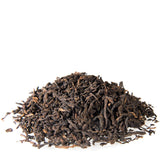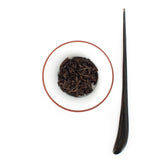Long ago, the wise tea master Lao Cha was on a pilgrimage through the mountainous ranges of Guangxi province, China, when he stumbled upon a tired farmer:
— Sifu, do you have something that is comforting, like rice porridge, yet sweet, and at the same time uplifting, like coffee, that will help me tackle all this work?
— Of course, my friend! Let me share a basket of Liu Bao with you.
Liu Bao can be considered the sister and, at the same time, the forefather of Shou Pu-erh. This tea originated from Guangxi Province in China and dates back to the 1500s. Farmers age it using large bamboo baskets. The production of Liu Bao involves post-fermentation – the same process that tea producers later adapted to create Ripe Pu-erh.
Compared to Ripe Pu-erh, this tea has a lighter body, and the taste is more nuanced. Liu Bao is sweet and soft, earthy, with deep notes of red dates, tobacco, and betel nut.
Liu Bao Hei Cha is made using slow fermentation. Similar to pu-erh, it involves Kill Green (杀青 – Sha Qing) at a stage closer to green tea, followed by Rolling (揉捻 – Rou Nian), Sun-drying (晒干 – Shai Gan), and finally the Post-Fermentation process ( 後發酵 – Hou Fa Xiao). It's when the leaves are placed into a hot and humid environment, which allows microbial fermentation to begin and soften the flavor. For traditional Liu Bao, this process is similar to Wet Piling (渥堆 – Wo Dui), but less intense – the temperature and humidity are lower, the piles are smaller, and the tea is left to ferment for a longer period. This gentler fermentation allows preservation of more of the leaf's original qualities. After that, the tea is dried, placed into bamboo baskets, and left to settle.
According to Traditional Chinese Medicine, Liu Bao has both heating and cooling properties (Yin and Yang). It made Liu Bao Hei Cha very popular with Chinese mine workers who went to work in Malaysian tin mines. Large amounts of this tea were exported to Malaysia, where the workers would drink it to combat the harsh and damp conditions of the mines and expel excess dampness from their bodies. Today, you can still find old traditional Liu Bao supplies across Malaysia. Furthermore, locals love drinking this tea in the humid climates of Guangdong and Hong Kong.
![]() 212℉ / 100℃
212℉ / 100℃
 1g per 70-100ml
1g per 70-100ml ![]() 3-5min
3-5min
 1g per 20ml
1g per 20ml ![]() Rinse. Then 15sec + 5sec for each subsequent infusion
Rinse. Then 15sec + 5sec for each subsequent infusion





